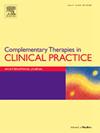Transcutaneous electrical acupoint stimulation combined with core stability training in postpartum women with diastasis rectus abdominis
IF 2.2
3区 医学
Q2 INTEGRATIVE & COMPLEMENTARY MEDICINE
引用次数: 0
Abstract
Background
Diastasis rectus abdominis (DRA) women experience discomfort signs, which had a negative impact like an impairment of the quality of life and functional capacities of women. Transcutaneous electrical acupoint stimulation (TEAS) and core muscle training (CMT) have provided increasing evidence as an important strategy for DRA. Here, we aimed to evaluate the effect of transcutaneous electrical acupoint stimulation (TEAS) combined with core muscle training (TEAS + CMT) in postpartum women with DRA.
Methods
A total of 96 postpartum women with DRA were randomly assigned to three groups: control (waiting-list group), treatment group 1 (CMT), and treatment group 2 (TEAS + CMT), with 32 participants in each group. Ultimately, 90 participants completed the study (30 in each group). The control group received conventional postpartum natural recovery. Treatment group 1 underwent CMT once daily, five times per week, for four consecutive weeks (one treatment course). Treatment group 2 received TEAS + CMT following the same schedule. Changes in interrectus distance (IRD), waistline (WL), body mass index (BMI), lumbago (measured by the Short-Form McGill Pain Questionnaire [SF-MPQ]), and quality of life (assessed via SF-36) were evaluated before and after treatment.
Results
At the end of treatment, each group showed notable reductions in IRD, WL, and BMI(P < 0.05), in with the most significant improvements observed in treatment group 2 (P < 0.05). Lumbago scores (SF-MPQ) distinctly decreased each group (P < 0.05), while quality of life scores (SF-36) evidently improved (P < 0.05), with treatment group 2 showing the most pronounced effects (P < 0.05).
Conclusion
TEAS + CMT may improve DRA of postpartum women, reduce WL and BMI, alleviate lumbago, and improve quality of life.
求助全文
约1分钟内获得全文
求助全文
来源期刊

Complementary Therapies in Clinical Practice
INTEGRATIVE & COMPLEMENTARY MEDICINE-
CiteScore
6.30
自引率
6.70%
发文量
157
审稿时长
40 days
期刊介绍:
Complementary Therapies in Clinical Practice is an internationally refereed journal published to meet the broad ranging needs of the healthcare profession in the effective and professional integration of complementary therapies within clinical practice.
Complementary Therapies in Clinical Practice aims to provide rigorous peer reviewed papers addressing research, implementation of complementary therapies (CTs) in the clinical setting, legal and ethical concerns, evaluative accounts of therapy in practice, philosophical analysis of emergent social trends in CTs, excellence in clinical judgement, best practice, problem management, therapy information, policy development and management of change in order to promote safe and efficacious clinical practice.
Complementary Therapies in Clinical Practice welcomes and considers accounts of reflective practice.
 求助内容:
求助内容: 应助结果提醒方式:
应助结果提醒方式:


